#the combination of censorship not letting them go wild with the stories and writers who dont know how to write women.
Text
ive given up on destined. its not happening. we must reckon with the fact that 95% of cdramas, even popular cdramas, are either morally corrupt or just really boring. i just want crazy bitches obsessed with each other and if not that then by god Something else has to be happening in the plot. how did they take a trope like marriage to lovers which is rife with built in conflict into something so goddamn boring and vanilla. and i dont like how songyi cant move her eyebrows that much like girl can u make some expressions. and pairing her w bai jingting who makes almost too many expressions. songyi thinks shes shooting a magazine cover and bai jingting is shooting a comedy its untenable. the sets and lighting are nice tho 5/10 final verdict
#would it kill them to write compelling characters even if these are stupid romance dramas#the combination of censorship not letting them go wild with the stories and writers who dont know how to write women.#results in shows that are unwatchable#i gave destined more than a fair shot i got 6 or 7 episodes in#whatever im dipping#destined#sidney talks shit
2 notes
·
View notes
Text
Queering KH Part 4: Hearts in Tune
Actually KH Finally lol

Pictured: Riku humming Sora’s name in a soft, adoring, wistful voice the way a swooning straight person sighs the name of their beloved of the opposite gender.
Kingdom Hearts gives off so many subtextual signals of queer coding that it genuinely BAFFLES me how people can really believe it is straight. You may be wondering what makes me so confident in that when there has not been anything in the games to explicitly prove any of the characters are not straight, and I will be happy to tell you. It is because in order to believe Kingdom Hearts is straight, you have to ignore WAY too much subtext. To truly believe that Sora is in love with Kairi and only coded to be interested in Kairi, you have to ignore his questioning of what love is. You have to ignore the combined keyblade he shares with Riku. You have to ignore how much the narrative is driving him to understand that Riku is his most important, cherished person. This all goes doubly for Riku who has a coming out story not unlike Elsa’s metaphorical one, in which his love for Sora is his greatest source of strength. You have to pretend the necklace gifting plot point is entirely straight and cannot possibly mean anything homoromantic. You have to ignore the way Sora cries while clutching Riku’s hand compared to his subdued and non-emotional reunion with Kairi- that’s just too much “accidental subtext” for me to confidently ignore lol. Intentional or not, KH is Gay~
Here’s how we’re gonna do this.
So where the hell do I even begin with coding KH? Well- I can’t possibly queer the whole of KH text in 1 summer, so what I plan to do is this:
Give you the tools to understand KH’s coding so that you can code it yourself~
Queer a few major KH scenes so that everyone can see that the proof is in the pudding.
I’m gonna try to break down various scenes to decode them and queer them so you can see what’s at play in KH. Originally when this meta was a single doc, I was only gonna cover 4 scenes. But since I’m breaking it into parts to update at my leisure, I’m gonna just add scenes and meta as I go~
Now without further ado:
How the Hearts in Tune scene is Gay Coded
This shouldn’t be too hard at all.~

This scene is almost too easy.
The scene opens with Sora bringing Mickey the sound idea he found but as it turns out, one sound idea is not enough. Sora tells us not to worry because he has a friend who is always picking up the slack for him. Likewise, on Riku’s end, he brings his sound idea to Mickey and is surprised to see that Sora’s sound idea is necessary to complete the song.
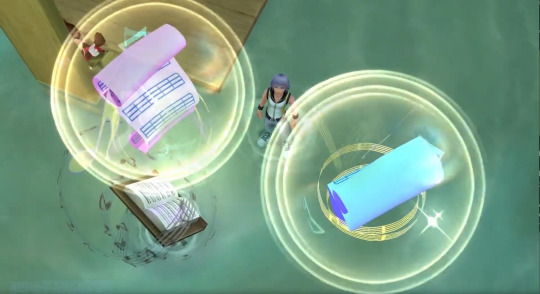
Once the sound ideas meet, this beautiful visual plays out in which the 2 sound ideas swirl around each other and the soundtrack title “Dearly Beloved” plays.
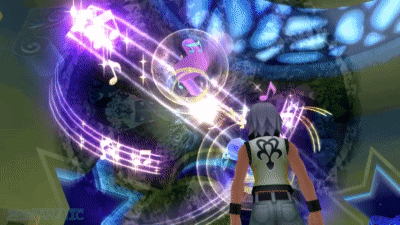
Now, there are several things I want to note about this sequence- heck this visual alone before we move on.
Recall earlier when I discussed Shiki’s point that blue and pink (likewise blue and red) “go together”, romantically.

I will let the visual of Sora’s sheet music being pink while Riku’s is blue speak for itself. But I will also add how this ties into the yin and yang themes I’m about to discuss:
Yin and Yang
This concept gets its own section because it’s such an influential concept in so many aspects of various cultures around the globe.
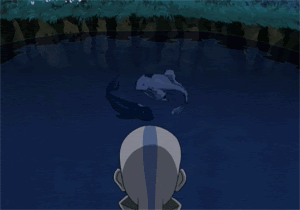
Yin and Yang is an eastern philosophy which illustrates the concept of dualism. In short, it is the concept that 2 opposite halves are complements to a whole. The original term in fact translates to dark-bright.
I am neither a philosophy professor or student so I will keep this as brief as I can and simply encourage you to study up on Yin and Yang at your own leisure. I will however paste this section from wikipedia because I think it is extremely helpful information to have for studying eastern media in general.
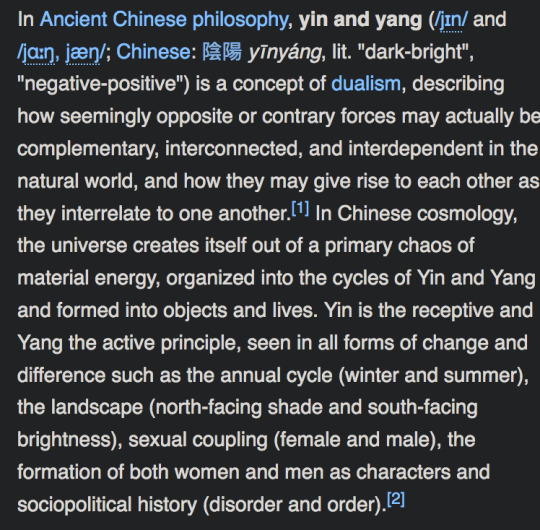
Yin and Yang: husbanded opposing forces. Dark-Light, Moon-Sun, Chaos-Order, Winter-Summer, Negative-Positive.
Female (Yin)-Male (Yang): Yes this is often used in a heteronormative heterosexual context because people are homophobic and believe in gender binaries, unfortunately, but I implore you to consider the concept in more figurative, spiritual, aesthetic themes, especially since Yin and Yang is a much grander philosophy than mere sexuality discourse; it’s about complementary forces creating a whole.
For shipping purposes, think opposites attract. Think concepts that are traditionally associated with femininity meshing with concepts that are traditionally associated with masculinity. Queer media has a wonderful way of subverting heteronormative Yin and Yang tropes by showing that cis-hetero standards can be hypocritically non-compliant with the complementary concept.
Rather than thinking of this, 2 heteros in love based on being just- the same person with opposite genders:
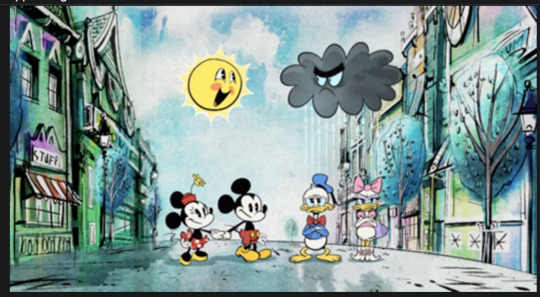

Think of this, same gendered couples with complementary personalities:
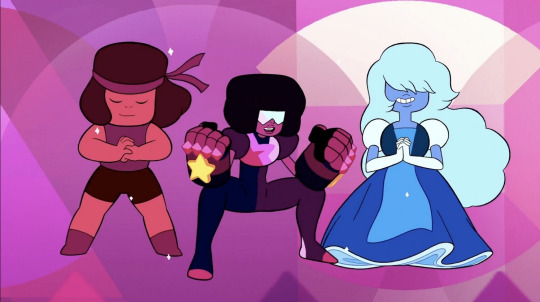
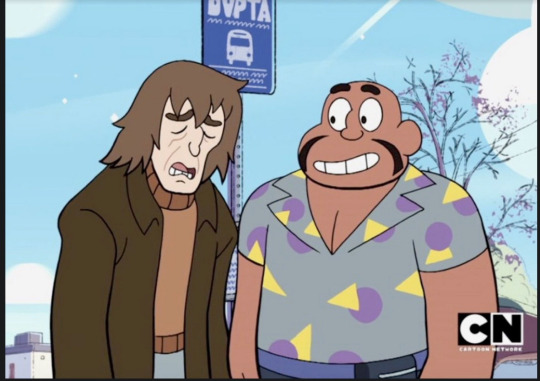
Think about how an aloof scrappy butchy vampire queen attracts an uptight calculating femme princess.

Think about how this goody-goody dumb jock with a martyring hero complex attracts this naughty cunning jock with a self-loathing villaness complex.
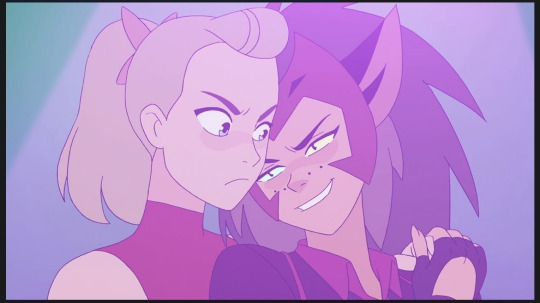
And now think about how badly we need more canonical mlm couples in children’s media lol. Oops my finger slipped. But I’m getting ahead of myself lol.
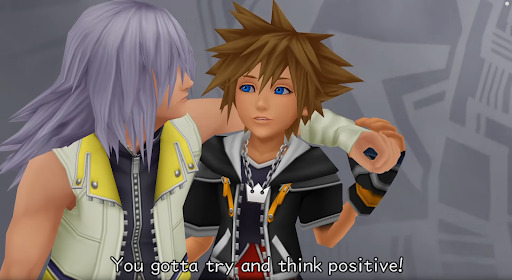
The concepts of interconnected opposite forces are so important and prominent in literature throughout the world, but yin and yang is ESPECIALLY important in Kingdom Hearts because it is a story that explicitly explores Light and Dark forces. It explores how they both oppose one another in catastrophic ways,

and how they complement each other in harmonious ways.

Getting ahead of myself again… But hey speaking of harmony, back to the matter at hand.
Hearts in Tune.

This scene shows a number of romantic symbols. As I was saying before the yin and yang tangent, pink and blue (nee red and blue) are already symbols of romantic suggestion. And in the case of them representing 2 parts of a whole song, these song pieces act as complementary halves, adding another layer of dualism to the scene. Furthermore, the music sheets swirl around each other in a yin and yang fashion. Harmony has been achieved. This lets us know these forces belong together. These forces representing Sora and Riku. They are husbanded together. These 2 hearts in question are part of each other. In fact, Mickey even says so:

Perhaps most damning, however, is that the song in question is “Dearly Beloved”, arguably the theme song for Kingdom Hearts as far as the score goes. I’m sure it goes without say that “Dearly Beloved” is not only in itself a romantic sounding phrase but it is also the phrase specifically said by officiators of weddings to the congregation before the wedding vows are exchanged. “Dearly Beloved, we are gathered here today…”
I will also mention that Riku’s dream eater symbol visible in the shot is specifically designed based on a bleeding heart flower, a symbol of passionate love. Credit to Steam for pointing this out here, please follow them and read their posts they are magically delicious:
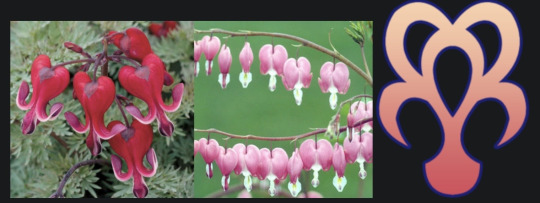
So almost everything about this scene is aesthetically romantically coded, and I didn’t even mention the fact that Dream Drop Distance’s whole color palette is themed with rainbows, which as I said earlier is absolutely still a gay symbol in Japan. Note the rainbow of colors animating from the sheet music.

So in terms of the atmosphere of the scene, its already incredibly homoromantic in every way I can think of. But what about the dialogue?
Well lets talk about the dialogue. Dialogue should always been read with care when you’re trying to queer a text. Often a lot of queer messaging in a text is subtextual. This means the text itself may actually say something gay, but you have to read further into it. This is an old method of queer writing designed to protect the writer from getting in trouble for their gay crimes.
Historical aside on this: If you’ve ever read Oscar Wilde’s “The Picture of Dorian Gray”, you may have note that Lord Henry can never just simply say that he is gay, lest Oscar Wilde be charged for homosexuality in 19th century England. Instead, Lord Henry simply tells us he is married to a woman, but makes it clear throughout the text that this marriage is mostly performative and he is not emotionally invested in it whatsoever, going against the puritanical, heternormative ideals of Victorian prudery. Lord Henry is by contrast MUCH more invested in following the life and times of his very close friend Dorian Gray, with whom he shares a hedonistic philosophy in the name of Fin de siècle. Not to be a downer but for the sake of understanding how real this subject of oppressed gay censorship is, despite keeping the homosexual themes as purely subtext, Oscar Wilde was tried and convicted of homosexuality and this book was used against him in court.
What we are privileged to have today with KH is a cutscene and not just a script. Meaning we have visuals, animation, voice acting, musical cues, etc etc to follow along with to enhance our subtext.
On Sora’s end of the conversation, Mickey points out that the song is incomplete with just his sound idea alone, and Sora tells him not to worry, as Riku is his dependable friend who will fill in where he fails. The text in the official English translation is:
Mickey: That's strange... Is one Sound Idea not enough?
Sora: Don't worry. I've got a friend out there who will help. He's always
picking up the slack for me.
This on its own sounds platonic. But note just how affectionate Sora’s voice acting is when he says it. Not only that, he clutches his heart to let us know how close he is to Riku and how much his connection with Riku matters to him. How much confidence he has in this friend he cares so much about. He then closes his eyes after saying it, smiling up in the air blissfully while he waits for their hearts to make their connection and finish the song.
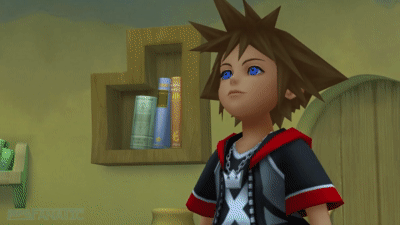
Once it is finished, Mickey remarks that their sounds joined together to make something more powerful. Sora then says looking thoughtful, “Yeah. Two forces are better than one. Right, Riku?”

Following this, Sora leaves to fight the boss.
On Riku’s side, Mickey questions what happened, and Riku looks up thoughtfully, and says tenderly, “Sora.”

Mickey comments “Sora? Funny... Just hearing that name kinda makes me wanna smile.” and Riku tells him warmly, “Yeah. That's how he is.”
Mickey then goes on to say some really shippy stuff:
“Whaddaya know... Riku and Sora. The Sound Ideas you two set free joined together. And when they did, they made a great and powerful harmony.”
Riku then nods and tells Mickey brightly that “Sora can find the brightest part of anything, and pull off miracles like there's nothing to it. It's pretty hard not to smile around him.”
And I would like to pause to look at that line. “It’s pretty hard not to smile around him.” Although Mickey says the same thing, that just hearing Sora’s name invokes a smile, we sense a somewhat deeper meaning in Riku saying it. Why is that? Well, for one thing this game is entirely about Riku protecting Sora and exploring how much Sora actually means to him. This game is continuing Riku’s redemption arc from KH2, but it is also doing something perhaps even more important: it is providing him a journey of self discovery. This test resets Sora and Riku to level 1 so to speak, not just in their powers but even their models revert to variations of their KH1 selves. This helps to underscore Riku re-examining himself and his feelings.
And then guess what? Mickey makes some even SHIPPIER commentary. He exclaims “Wow! No wonder the music sounded like so much fun. But I bet he's got you to thank for that. Having such a good friend means he could really enjoy it.”
Riku is taken aback by this comment. “Huh?”
Mickey continues, expressing some extremely yin and yang themed sentiments,
“It's like each of you is holding on to a little part of the other. Your hearts are always in tune, so they're free to sing. Gosh, I hope I can be part of the team someday.”
Mickey did us a wonderful favor and expressed to us explicitly, for those who didn’t understand the romantic coding of the scene already, that Sora and Riku are a good match. Mickey tells Riku that the music sounded like fun in English, that it was a happy, pleasurable time, and tells him that Sora has Riku for a friend which is what must have made it so enjoyable.
So from this dialogue we get assurance that Sora and Riku are two very close friends, whose hearts are connected, and they are 2 powerful forces that merge into an even greater one. Their hearts are in tune.
Now if this were a scene about a boy and a girl, I doubt anyone would question whether it was romantic. Why should we be asked to look at it platonically just because it is 2 boys? The romantic imagery is clear.
And let me ask you this while we’re still on the subject of Dream Drop Distance:
According to Riku’s character files, he had previously thought of Sora as a little brother, and tried to be a cool older brother to him.
He then tells us that this has changed. What did it change to?
The surface level, heteronormative answer would say it changed to them being merely friends.
But isn’t that an odd regression? After all, found family is a thing, and that’s a bit weird for him to question since there is no reason for those feelings to change on that notion. If Sora loved him like a brother, that clearly hasn’t changed. Riku clearly loves Sora as deeply, so that didn’t change. The other problem with this phenomenon Riku is dealing with is that there is no reason for him to feel this strange sense of repression we keep seeing over this change. He is constantly holding back on some feelings for Sora but platonic and brotherly feelings are entirely acceptable. What is it that he is hiding? What sort of feelings for Sora would be hidden?
From the Kh2 Novel:
He really did want to see Sora and talk. But that was impossible with this appearance. The things that mattered the most were what he couldn’t tell Sora. It had always been that way.
What sort of feelings might be systemically oppressed?

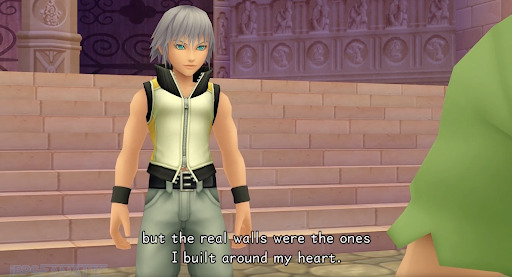
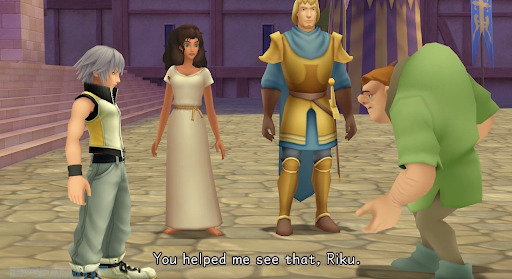
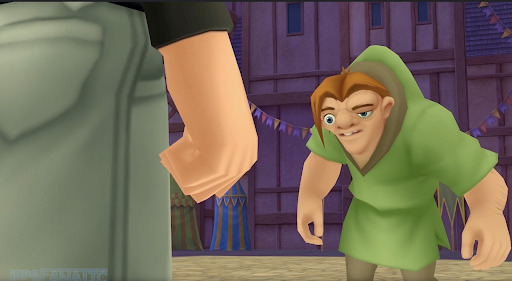
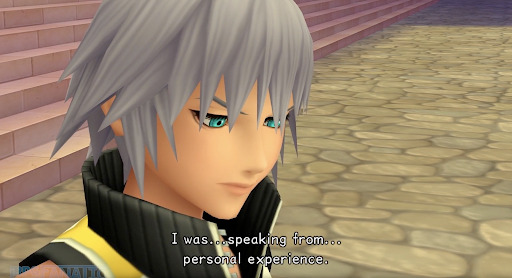
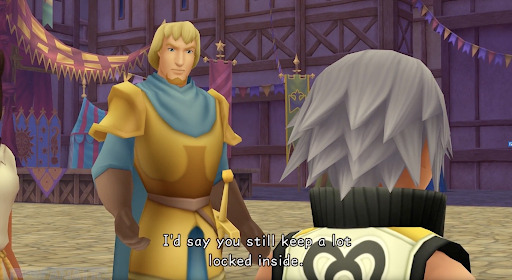






This scene is pretty much EXACTLY what I would do to say as explicitly as possible that Riku is gay without being able to say it outright due to censorship.
73 notes
·
View notes
Text
20 Banned Books you've probably read
Banning books from schools and libraries is a form of censorship that predominantly hurts the people that would benefit most from keeping the book(s) available. It is not up to a few to say what book is available to who. Making a choice for a group of people based on the decision of a small group is morally wrong in my opinion. There is a difference from a book being challenged, which probably happens to just about every book at one point, and banning, which is when the book is actually removed from a library or school. The following is a list of some of the best books ever written that were banned at one time or another.
1. The Scarlet Letter by: Nathaniel Hawthorne (1850)
A woman has an affair with a man of the church which results in a love child. As a punishment for her transgressions, she has to wear the scarlet letter “A” for Adulterer. There were some that felt the author was too lenient in the character Hester and that she didn’t get what she deserved. There was complaint of immoral content and sympathy to the sins committed. Considering the time this was written, this one isn’t too surprising.
2. Alice’s Adventures in Wonderland by Lewis Carroll (1865)
My wedding was Alice in Wonderland themed so this is obviously one of my favorite books. This has had some controversy because of suggested drug use (eating mushrooms that change your size, a caterpillar smoking a hookah…) as well as speaking animals which is considered evil or something. It was banned in Hunan China for that reason in 1931 because of the way the animals acted like humans. The Censor General feared children would see animals and humans as equals and also believed allowing the animals to speak was offensive to humans. I have also read something about the author’s sexual preference, but that refers to Lewis Carroll, not the story.
3. The Adventures of Huckleberry Finn by: Mark Twain (1884)
I enjoyed this book quite a bit growing up. I was oblivious to the racism in it as a child, but ultimately that is why it was banned. Now, of course racism isn’t ok, but during the time the story takes place (and at the time it was banned oddly enough), racism was a very large part of everyday life. Jim was Huck’s friend and seeing the way he was treated was cruel. Though, I personally feel it was showing the intensity of racism many feel like the book itself was racist. While it may have been called “trash”, it is now considered an American classic.
4. The Tale of Peter Rabbit by: Beatrix Potter (1902)
When I saw this book was banned, I couldn’t think of a single thing that would do it besides the fact that Peter’s father was killed. That wasn’t it. This book was banned for portraying “Middle class rabbits”. Yep. I don’t even really know what that means, so while I technically know why the book has had controversy, I’m still really confused.
5. The Great Gatsby by: F. Scott Fitzgerald (1925)
This was fairly recently made into a film that did well, and it’s a favorite of many readers, but this novel has had its fair share of complaints. The novel contains a sexual affair (which is never portrayed in detail), bad language, and violence, which is the formula to set people off. The novel is set during the prohibition where the drinking was heavy and the partying described was also considered uncomfortable to some.
6. Winnie the Pooh by: A.A. Milne (1926)
Pooh? Pooh was banned? This one was a little all over the place. The talking animals being against God is brought up with this one as well. Piglet being a pig had some controversy over if it would offend Muslim children. One thing that blew my mind, was apparently pooh wore a swastika and was seen as a Nazi supporter. It’s been awhile since I’ve read it, but I don’t remember that.
7. Gone with the Wind by: Margaret Mitchell (1936)
This is the only book on this list that I have never read, which is horrible considering I am a romance writer. I will remedy that soon, but that is neither here nor there. The book was primarily banned because of the racism and the way they treated slaves. Like I said, I haven’t read it, but I’m pretty sure slaves were never treated well, hence the name “slave”. As an author I strive for authenticity, and while slavery has never been acceptable, it did happen. Slaves were, in fact abused, so reading about it isn’t going to be pleasant.
8. Of Mice and Men by: J.D. Salinger (1937)
I remember the effect this book had on me the first time I read it. While it was intense I still don’t feel as if I was too young to be reading it (around 12). A major complaint was that this book didn’t fit in with the age group it was being taught to in schools. There is bad language and violence, but another problem was that the book glorified euthanasia. That seems like a bit of a stretch to me, but ok.
9. The Catcher in the Rye by: J.D. Salinger (1951)
The Character Holden is often compared to number three’s main character Huckleberry Finn. The book follows a teenager who has a pension for drinking (Underage) and a potty mouth. Those were two large reasons the book was banned combined with sexual content. While the book still faces controversy, it has come back from being banned and continues to have an influence on teenagers all over the United States.
10. Fahrenheit 451 by: Ray Bradbury (1953)
Yeah, a book about burning/banning books was itself banned. No irony there. Yes, there is bad language, blasphemy, as well as the bible being burned, which is what lead to the banning, but I think the message of this one was lost on more than a few.
11. Lord of the Rings by: J.R.R. Tolkien (1954)
This was another beloved book that spawned multiple, wildly popular films. One issue with this book is the smoking. The characters do smoke, from a pipe mostly, but if we ban all books with smoking in them… that is a lot of books. The magic involved is seen as witchcraft and un-Christian. What I find interesting is that apparently, J.R.R. Tolkien was not only a Catholic, but the book are said to be symbolic to Christianity. Similar to The Lion, The Witch, and The Wardrobe by C.S. Lewis (with whom he was actually friends).
12. Lolita by: Vladimir Nabokov (1955)
When I first heard what this book was about, I was shocked that it was put into print, but later found it was done so through a pornographic press. When my curiosity got the best of me and I read it, I was stunned because it was so beautifully written. Yes, the story is about a pedophile that makes my skin crawl, and is infatuated with a twelve year old, but the truth is, it was so tastefully told that it didn’t make me as uncomfortable as it would have otherwise. Humbert Humbert was the narrator, and I hated him, but still, I loved the book. France, United Kingdom, Argentina, New Zealand and South Africa have all banned it for its obscenities and is was temporarily so in Canada.
13. Green Eggs and Ham by: Dr. Seuss (1960)
I thought for sure we would have more talking animal issues, but the only complaint I have been able to find is that portrayed “early Marxism”. Dr. Seuss was open about the fact that he wanted kids to question their government. From what I can gather (because I had no idea what that meant), Marxism is a belief that our social class system, and the constant conflict between upper and lower class, is responsible for the way history has turned out. And apparently that’s why it was banned, but the ban has been lifted since the death of Dr. Seuss.
14. One Flew Over the Cuckoo’s Nest by: Ken Kesey (1962)
This book is pretty crazy. There is a lot of sexual material and has been called “pornographic”. Many parents and school boards have fought to get this removed from shelves. It was said to glorify immoral activity and the profanity, torture, and death was seen as inappropriate for high school students. Let me just say, the story is told by a character who is mentally ill, which I always saw as unique and eye-opening and is set in a mental hospital so it isn’t going to be gumdrops and unicorns.
15. Where the Wild Things Are by: Maurice Sendak (1963)
The fact that any childhood is without this book is sad to me, but when I saw why this book was banned, I had to laugh. Because Max was sent to bed without his supper, apparently his hunger sent him into hallucinations of monsters, and is “psychologically damaging” to young children. Really? Because he missed one meal? The book made it clear that Max has an active imagination and was rambunctious hence why his mother called him “Wild Thing”.
16. Where the Sidewalk Ends by: Shel Silverstein (1974)
This book is a fantastic compilation of poems that often have the message to not listen to everything you are told, and use your imagination. A lot of parents and teachers don’t like that message because they believe it teaches them to be disrespectful. It was also accused of having references of suicide, Satanism, and drug use. There is one poem called “Dreadful” about the baby being eaten and the narrator burps at the end insinuating he ate the baby. Ok, maybe it’s a little disturbing, but children are just going to find it funny and amusing, not resort to cannibalism as some parents were concerned would happen.
17. American Psycho by Bret Easton Ellis (1991)
In Australia, the book may be purchased by someone over the age of eighteen, but at one point in the State of Queensland sale and purchase of the novel was illegal. The story is of a man who is extremely concerned with how the world sees him is also a sadistic killer. It was a concern that the book would bring about violence. Simon and Schuster dropped the title three months before the book was scheduled to be released because of a lot of pushback from the media. The problem people had was with the inner dialogue of Bateman, but when you write, the characters become their own entity in a sense. That was who Bateman was, and being true to the characters and their story is the art of storytelling.
18. Harry Potter Series by: J.K. Rowling (1997 -2007)
The most common problem with these books, is the fact that the characters are good witches and wizards that perform magic. Since religious teachings say witchcraft, demons, sorcery, etc. are a sin against God, they feel this is confusing to children because the [main] characters are seen a good. The themes in the book can get somewhat dark and there were concerns that it would be too intense for children. However, the millions of adolescent Harry Potter fans would probably disagree. Another problem is the fact that Harry and his friends lie, sneak around, steal, and break other rules to accomplish what they are doing in the story. Parents were upset that he never got in trouble, but that’s probably because the headmaster was in on it half the time.
19. The Perks of Being a Wallflower by: Stephen Chbosky (1999)
This is a novel about teenagers coming of age. The sexual content is the main concern, especially the witnessing of date rape. There were complaints by parents for drug and alcohol use…did I mention the book was about teenagers? The mention of masturbation was reason for some controversy (Again…teenagers). What really got me, is the fact that people were appalled that homosexuality is even mentioned in the book. Like homosexuality is some terrible thing. You want to talk about offensive… and this was published less than twenty years ago.
20. Fifty Shades of Grey Trilogy (2011-2012)
Compared to the other books on this list, this isn’t exactly surprising, but I primarily read and write within the same genre as FSOG, and this book is like the training wheels for the genre. I kind of have to wonder what these people would say about books like “Captive in the Dark”. It was taken out of libraries for immoral content and sadism. They don’t want pornography or erotica in their libraries, and there were also concerns of the character’s religious views. It’s no secret what these books are about (Hot young Billionaire + Virginal young woman + mild BDSM= Book), so if someone wants to read it should be available for them to do so.
These are the books that have shaped us (Well, maybe with the exception of number twenty) and if these books aren’t safe, I don’t know that any books are. I am a proud reader of banned books and will do my part to fight censorship in any way possible.
*What would you add to the list? Did you enjoy this post? I would love to hear from you!
Charity B.
4 notes
·
View notes